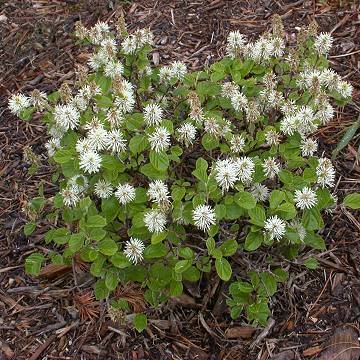

Fothergilla major - (image 1 of 7)
Taxonomy
Family: Hamamelidaceae
Habitat
Bluffs, dry rocky woodlands, talus slopes, riverbanks.
Associates
.
Distribution
Allegheny Mountains from northern NC and TN to northern AL. A small population occurs in AR.
Morphology
Small woody shrub to 10'. Leaves alternate, simple, asymmetrical, suborbicular to oval or obovate, 2-4" long, cordate to truncate, crenate-dentate or sometimes denticulate above the middle, glabrous above, Flowers (actually numerous long stamens) white or cream, without petals, in bottlebrush-like spikes, fragrant, opening as the leaves are expanding. Fruit a dry capsule containing 2 shiny black seeds, maturing in the fall.
Notes
Flowers April to mid May
Wetland indicator: Not available. Would expect that it is found more often in upland habitats.
The original range is the southeastern US but hardy to zone 4. Increasingly popular in the residential landscape for it's fragrant flowers, deep green foliage and excellent fall color. Prefers a neutral to acid soil. Long-lived. F. gardenii is similar but smaller.
Bibliography
Dirr, Michael A. 1998. Manual of Woody Landscape Plants:
Their Identification, Ornamental Characteristics, Culture, Propagation and Uses.
5th ed. Champaign, Illinois: Stipes Publishing L.L.C.
USDA, NRCS. 2002.
The PLANTS Database, Version 3.5 (http://plants.usda.gov).
National Plant Data Center, Baton Rouge, LA 70874-4490 USA.
|
Michael Hough © 2004 |